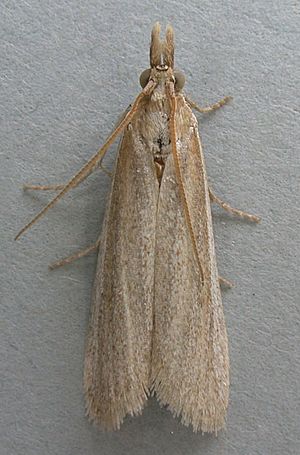Anerastia lotella facts for kids
Quick facts for kids Anerastia lotella |
|
|---|---|
 |
|
| Scientific classification | |
| Kingdom: | |
| Phylum: | |
| Class: | |
| Order: | |
| Family: |
Pyralidae
|
| Genus: |
Anerastia
|
| Species: |
A. lotella
|
| Binomial name | |
| Anerastia lotella (Hübner, 1813)
|
|
| Synonyms | |
|
|
The Anerastia lotella is a type of snout moth. It belongs to a group of moths called Anerastia. This small moth was first described by a scientist named Jacob Hübner in 1813.
Contents
About the Anerastia lotella Moth
The Anerastia lotella is a fascinating insect. It is known for its unique features and its widespread habitat. Let's learn more about where it lives and what it looks like.
Where Does It Live?
This snout moth can be found in many places around the world. It lives in most parts of Europe. You can also find it in western Russia, a region called Asia Minor, and in Iran. It also makes its home in western Turkestan.
Interestingly, the Anerastia lotella has also been seen in most areas of Canada. This shows that it can adapt to different environments across continents.
What Does It Look Like?
The Anerastia lotella is a medium-sized moth. Its wingspan is usually between 19 and 27 millimeters. That's about the size of a large coin!
Adult moths are typically seen flying during the month of July. This is when they are most active.
Life Cycle of the Snout Moth
The life cycle of the Anerastia lotella moth is quite interesting. It involves different stages, from egg to adult.
What Larvae Eat
The young moths, called larvae, have a special diet. They mostly eat different types of Poaceae plants. These are also known as grasses.
Some of their favorite grass species include Ammophila arenaria, Corynephorus canescens, and Festuca ovina.
How Larvae Live
The larvae are very clever. They build a silky tunnel, or "gallery," around the base of the plant stem. They also build it around the roots of their host plant. This gallery helps protect them while they eat.
You can usually find these larvae in May and June. Scientists believe that these moths spend the winter as larvae. This means they survive the cold months in their larval stage.
Pupation
After growing enough, the larvae change into pupae. This is a resting stage before they become adult moths. They create a silky cocoon for themselves. This cocoon is usually found in the soil, close to the plant they were eating.

